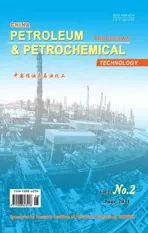Synthesis of H2WO4/GO and Its Oxidative Desulfurization Activity
2021-06-29WangZihaoLiXiupingHaoYangyangZhaoRongxiang
Wang Zihao; Li Xiuping; Hao Yangyang; Zhao Rongxiang
(College of Chemistry, Chemical Engineering and Environmental Engineering,Liaoning Shihua University, Fushun 113001)
Abstract: H2WO4/GO catalyst was synthesized by the immersion method and was characterized by using X-ray diffraction(XRD), Fourier-transform infrared spectroscopy (FT-IR), scanning electron microscopy (SEM), and nitrogen adsorptiondesorption measurements (BET). The characterization results show that H2WO4 has been dispersed on GO (grapheme oxide). H2WO4/GO was used as catalyst in the oxidative desulfurization of dibenzothiophene (DBT), with H2O2 acting as oxidant and acetonitrile acting as extraction agent. The experimental results show that the sulfur removal rate for DBT reach 99.2%, that for 4,6-dimethyldibenzothiophene (4,6-DMDBT) reach 95% and that for benzothiophene (BT) reach 42.8%under the optimal reaction conditions. Meanwhile, the recycled catalysts still exhibits good desulfurization performance after four operating cycles. The high activity and stability of catalysis is attributed to a small dose of H2WO4, which is highly dispersed inside the layers of GO. This desulfurization reaction follows the pseudo-first-order kinetics, and the apparent activation energy of the desulfurization reaction is 18.515 kJ/mol, which indicates that the H2WO4/GO used as desulfurization catalyst has demonstrated good desulfurization property for DBT.
Key words: H2WO4/GO; graphene oxide; desulfurization; catalysts
1 Introduction
Air pollution harms the human health. The combustion of sulfur compounds in liquid fuels is a major pollution source for air. It causes great concern from the people.Strict environmental legislations have been formulated to reduce the concentration of sulfur in fuels[1].According to these legislations, the sulfur content is limited to10 μg/g, which will place an urgent pressure upon oil refining industry[2]. However, the conventional hydrodesulfurization (HDS) technique only can remove aliphatic sulfides, such as disulfides and mercaptans,since it is ineffective to remove dibenzothiophene (DBT),4,6-dimethyldbenzothiophene, and thiophene[3]. If HDS can achieve deep desulfurization, more hydrogen would be consumed under strict operating conditions[4]. To overcome these disadvantages of HDS, many potential desulfurization processes have been proposed, such as bio-desulfurization, alkylation desulfurization, extractive desulfurization, adsorptive desulfurization, and oxidative desulfurization (ODS)[5]. Compared with these deep desulfurization approaches, the ODS exhibits more advantage in terms of high efficiency, low cost, and mild reaction conditions[6].
Recently, the heterogeneous catalysts have been wildly used in the ODS process[7]. Among them, WO3can be used as the catalyst because of its excellent thermal stability and good crystalline structure[8]. However, it has a disadvantage of small surface area, resulting in shortage of active sties. Therefore, it is essential to disperse H2WO4on supports to improve its activity. Xiao, et al.[9]reported that upon using a flower-like WO3·H2O functioning as catalyst in an organic biphasic system coupled with H2O2acting as oxidant, the desulfurization rate can reach up to 100%. Zhao, et al.[8]reported the desulfurization rate of simulated oil can reach 91.2% under optimal conditions using WO3/g-C3N4as catalyst. Li, et al.[10]investigated that upon using the tungstic acid and quaternary ammonium salt as catalysts, the desulfurization efficiency was mainly dependent on the alkyl chain length of the quaternary ammonium salt.
The conventional supporter includes SiO2, SBA-15,Al2O3, g-C3N4, and ZrO2[11]. However, these supporters have the disadvantages of difficult preparation and high production cost. Nowadays, graphene oxide (GO) has been attracting great attention in the field of chemistry,since GO can be applied in hydration of alkynes[12],oxidation[13], oxidative coupling[14], polymerization[15], and other processes. On the other hand, GO as the supporter[16]featuring high specific surface area, excellent mechanical strength, and low cost has been researched extensively in deep oxidative desulfurization process. Ding, et al.[17]reported that the removal rate of thiophene could reach 87.6% by using PMoA/GO as the catalyst and 30% H2O2as the oxidant at 70 ℃. Dizaji, et al.[18]prepared a novel heterogeneous phosphomolybdic acid catalyst supported on GO (HPMO/GO), and this catalyst could achieve an desulfurization rate of 100% for DBT and 4,6-DMDBT.Menzal, et al.[19]reported the inorganic hybrid materials containing GO, which could be used in removal of sulfur compounds. Compared with the traditional porous carrier,graphene oxide is a kind of two-dimensional material,which can effectively prevent the blockage of pores[20].In addition, the oxidative desulfurization performance of catalysts can be enhanced significantly due to the high adsorption capacity of GO[21].
In this study, the H2WO4immobilized on GO as a recyclable and efficient catalyst is applied in ODS system,using H2O2as oxidant and acetonitrile as extraction agent. In addition, the reaction temperature, the loading amount of catalyst, the O/S molar ratio, the amount of catalyst, the dosage of extraction agent and different sulfur-containing compounds are investigated. The desulfurization mechanism is also proposed.
2 Experimental
2.1 Materials
Dibenzothiophene (DBT, ≥99.0%), 4,6-dimethyldibenzothiophene (4,6-DMDBT, ≥98.0%), benzothiophene(BT, ≥99.0%) and H2WO4were purchased from Aladdin. 30% H2O2,n-octane, CCl4, and acetonitrile were purchased from the Sinopharm Chemical Reagent Co. Graphene oxide (GO) was obtained from the Suzhou Tanfeng Graphene Technology Co., Ltd. The analytical instruments included a WK-2D comprehensive microcoulomb analyzer (Jiangsu Jiang Electric Analysis Instrument CO., Ltd.), a X-ray diffractometer (D/Max-2500, using Cu-Kα radiation, withλ=0.15418 nm,and operating at a tube voltage of 40 kV, made by the Rigaku Corporation of Japan), a FT-IR spectrometer(SPECTRUM-400, KBr pellet, PerkinElmer), a highperformance adsorption analyzer (ASAP2020, made by Micromeritics, USA), and a SEM-EDS instrument (Philips XL 30, made by Philips, Netherlands).
2.2 Preparation of H2WO4/GO catalyst
H2WO4was dissolved in the H2O2solution (containing 5 mL of H2O2and 30 mL of water), then GO at different mass ratio was added into the above solution. Finally,H2O and H2O2were removed by heating and the product was dried at 100 ℃ in a drying oven. H2WO4/GO samples with various H2WO4mass contents were obtained. The H2WO4/GO samples were determined to be 3%-H2WO4/GO, 5%-H2WO4/GO, and 7%-H2WO4/GO according to the loading dose of H2WO4.
2.3 Characterization
X-ray diffraction (XRD) patterns were recorded on an XRD7000 diffractometer (Shimadzu, Japan). The diffractometer was equipped with a Ni-filtered Cu-Kα radiation source (λ=0.15406 nm), operating at a tube voltage of 40 kV and a tube current of 40 mA with a scanning angle (2θ) range of 10º—70º through each step of 0.02º. Scanning electron microscopy (SEM, JEOL 6701 F) was used to observe the morphology of samples.The FT-IR spectra were recorded with a Nicolet Nexus 470 FT-IR instrument using KBr pellets. The surface area analysis was performed from the nitrogen adsorption isotherms at 77 K with a Micromeritics Model ASAP2020 instrument. The average pore diameter and pore volume of samples were calculated based on the Barrett-Joyner-Halenda (BJH) method.
2.4 Desulfurization experiments
The model oil was prepared by dissolving 1.437 g of DBT in 500 mL ofn-octane to make a concentration of 500 μg/g. The oxidative desulfurization reaction was performed in a conical flask equipped with a condenser pipe. The model oil, acetonitrile, 30% H2O2, and the catalyst were stirred using magnetic stirrer at a specified temperature.After the completion of reaction, the upper oil phase was removed every 20 min and the sulfur concentration was determined with a WK-2D micro-coulomb analyzer. The desulfurization rate was calculated using the following formula[22]:

whereC0is the initial concentration of the sulfur compound in the model oil andC1is the residual concentration of the sulfur compound after the ODS process.
3 Results and Discussion
3.1 Catalyst characterization
3.1.1 X-ray diffraction characterization
The XRD patterns of H2WO4, GO andX%-H2WO4/GO are presented in Figure 1. The characteristic diffraction peak of pure GO appears at 10.7º, which is the interplanar stacking peak of aromatics[23]. The characteristic diffraction peaks of H2WO4clearly are revealed at 16.34º,25.56º, and 35.14º. No peaks of H2WO4appear inX%-H2WO4/GO. However, the peak at 10.7º in GO denotes a right-shift. Moreover, The shift of the peak at 10.7ºbecomes bigger and bigger with the increase of H2WO4dosage, which indicates that the H2WO4enters into the interlayers of pure GO, resulting in a slight expansion of the interlayers[23]. The finding indicates that the small loading amount of H2WO4would be highly dispersed on the surface of the GO nanosheets.
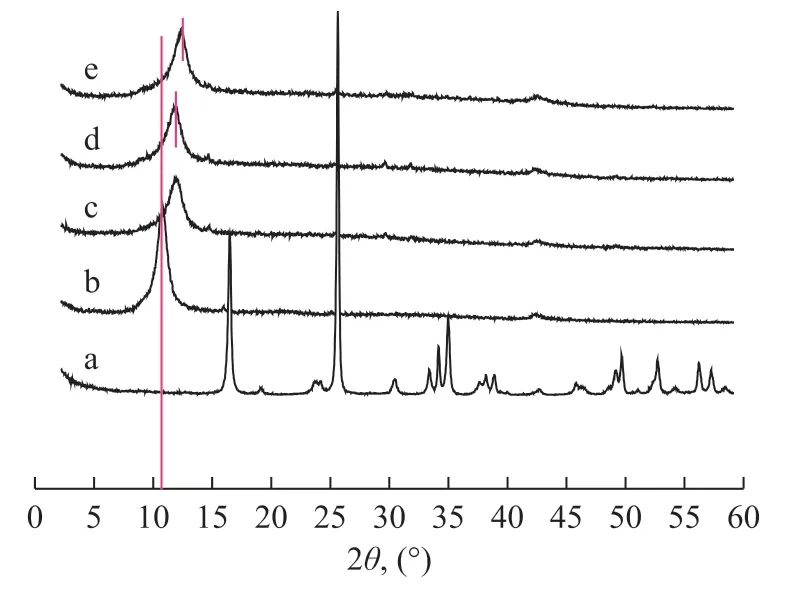
Figure 1 XRD patterns: (a) H2WO4; (b) GO; (c) 7%-H2WO4/GO; (d) 5%- H2WO4/GO; (e) 3%- H2WO4/GO
3.1.2 Fourier-transform infrared spectroscopy analysis
The FT-IR spectra of H2WO4, GO, and 5%-H2WO4/GO are shown in Figure 2. It can be seen from Figure 2 that for the pure H2WO4, the peaks at 946 cm-1and 660 cm-1are attributed to the stretching vibration of W=O and O-W-O, respectively[24]. The peaks at 1 719 cm-1,1 617 cm-1, 1 221 cm-1, and 1 047 cm-1can be attributed to the stretching vibration of C=O in the carboxyl group,the bending vibration of -OH, the vibration of C=C, the stretching vibration of epoxy group, and the bending vibration of C-O-C[25], respectively. The spectral curveof 5%-H2WO4/GO is similar to that of GO. However,the characteristic peaks of H2WO4are not observed,indicating that the small loading amount of H2WO4could be highly dispersed on the surface of the GO nano-sheets.The results are in accordance with those of XRD analyses.The peak at 3385 cm-1is attributed to the stretching vibration of -OH in water adsorbed on the surface of H2WO4and GO, and H2WO4and GO can easily adsorb water molecules from air because their charge is not balanced[26].
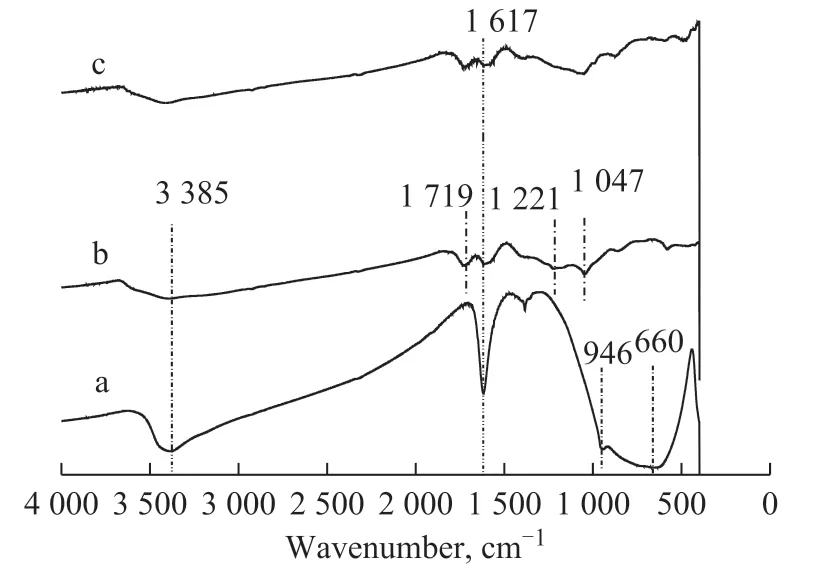
Figure 2 FT-IR patterns: (a) H2WO4; (b) GO;(c) 5%- H2WO4/GO
3.1.3 SEM and EDS analysis
In order to further prove that H2WO4existed in catalyst sample, the EDS analysis of catalyst was carried out. The SEM images of H2WO4, GO, and 5%-H2WO4/GO are shown in Figure 3. It can be seen from Figure 3(a) that the spherical particles of H2WO4were observed. The GO showed a typical laminated structure in the SEM image of Figure 3(b). The delaminated layer structure and wrinkles of GO can confirm that GO possesses high surface area,which is crucial for high loading capacity of GO[27]. The SEM image of 5%-H2WO4/GO is presented in Figure 3(c),showing that the catalyst has still retained the original structure of GO. But the layer structure of GO is more loose, and it further confirmes that H2WO4has entered the layers of GO. The elemental analysis of 5%-H2WO4/GO is presented in Figure 3(d). This catalyst sample contains three elements, namely: C, O, and W. These results show that this catalyst is the GO supported H2WO4.
3.1.4 BET analysis
Nitrogen adsorption-desorption isotherms of 3%-H2WO4/GO, 5%-H2WO4/GO, 7%-H2WO4/GO, H2WO4, and GO are displayed in Figure 4. It can be seen from Figure 4 that all the curves exhibit the type IV isotherms with a typical hysteresis loop, indicating the mesoporous structure of all the samples. The surface area of 3%-H2WO4/GO, 5%-H2WO4/GO, 7%-H2WO4/GO, H2WO4,and GO are depicted in Table 1. The surface area of 3%-H2WO4/GO, 5%-H2WO4/GO, 7%-H2WO4/GO, H2WO4,and GO is 47 m2/g, 28.08 m2/g, 25.34 m2/g, 14.61 m2/g,and 54.06 m2/g, respectively. The surface area ofX%-H2WO4/GO decreases with an increasing H2WO4content.It might be attributed to the assumption that the pores of GO are blocked due to the attachment of H2WO4[28].
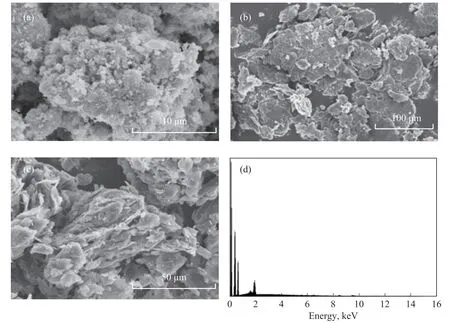
Figure 3 SEM patterns: (a) H2WO4; (b) GO; (c) 5%-H2WO4/GO; (d) EDS analysis
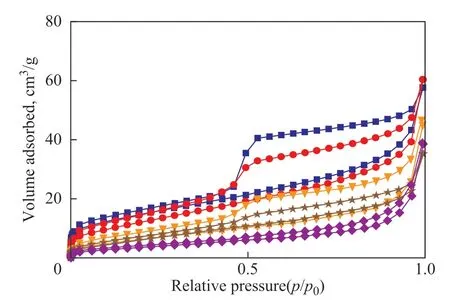
Figure 4 the Nitrogen adsorption-desorption curves of the composite, H2WO4 and GO
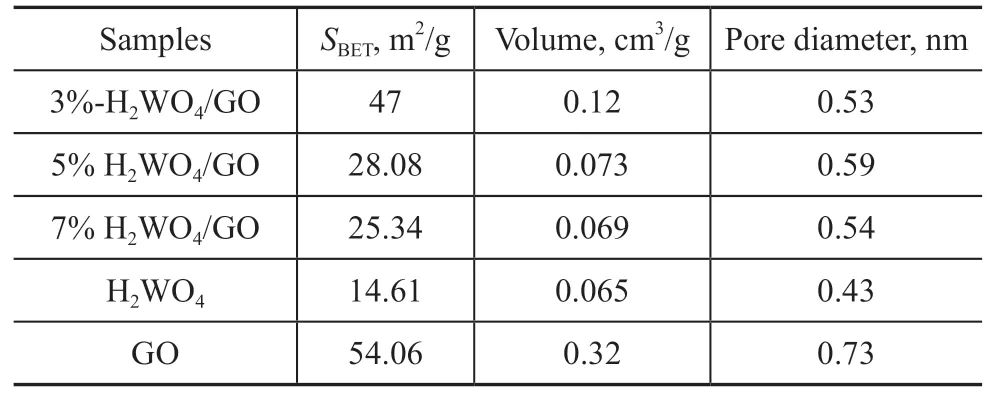
Table 1 Specific surface area and average pore size of samples
3.1.5 XPS analysis
XPS analysis was performed to determine the chemical state and bonding configuration of H2WO4/GO catalysts.In Figure 5(a), the XPS survey spectrum revealed that H2WO4/GO catalyst mainly consisted of C, O, and W elements. This result confirms the successful coupling of H2WO4and GO. According to the literature report[9], the peaks at 35.7eV and 37.8eV are attributed to W4f7/2and W4f5/2, respectively, showing the typical binding energy of W6+. However, in Figure 5(b), the binding energy of W4f7/2and W4f5/2in the H2WO4/GO are observed at 33.85 eV and 36 eV, and such a left-shift compared with that of pure H2WO4can be attributed to the interaction between H2WO4and GO. Electrons are transferred from GO to H2WO4,implying that W6+are partially reduced to W5+or W4+[29].
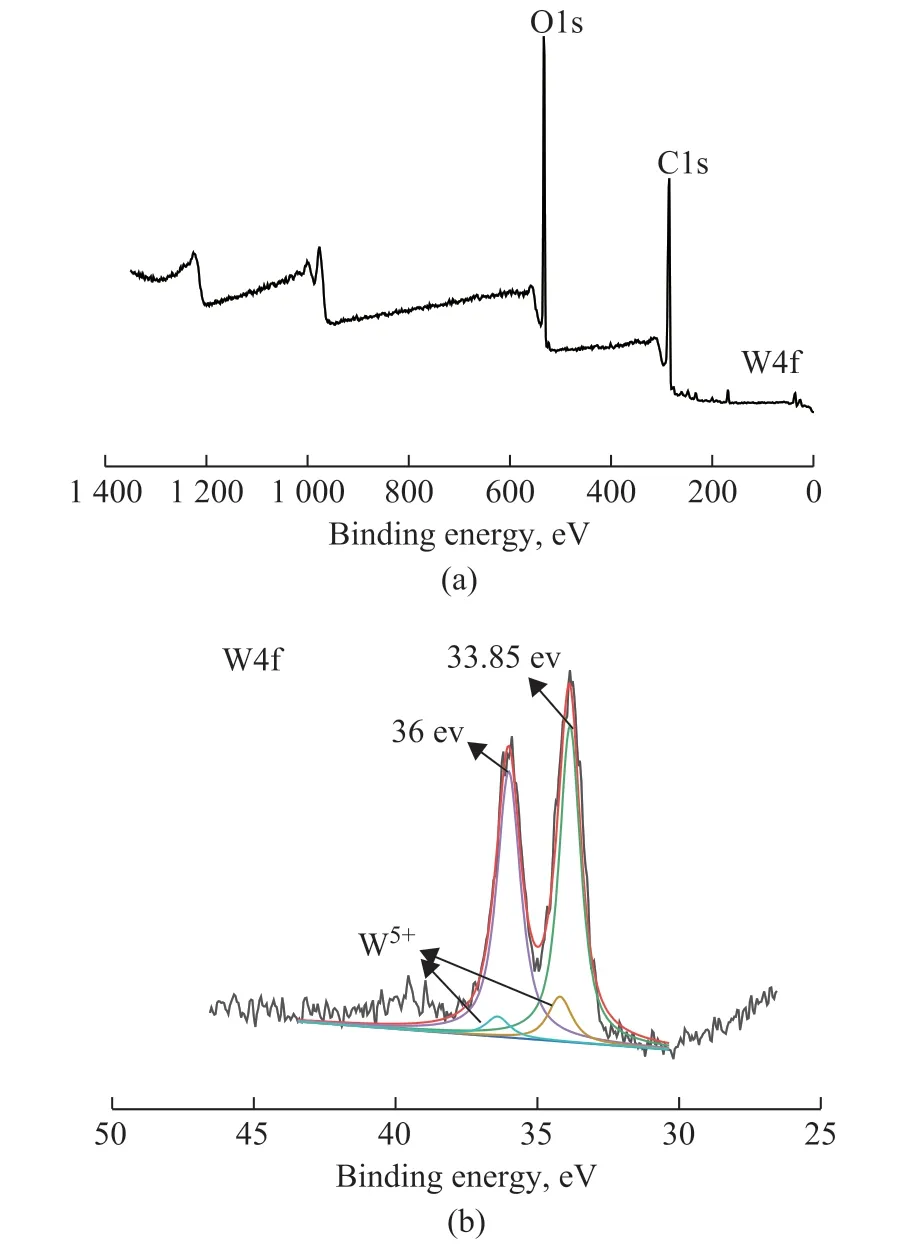
Figure 5 XPS spectra of H2WO4/GO: (a) survey of the catalyst, (b) W4f
3.1.5 The influence of different desulfurization systems
The influence of different desulfurization systems on removal of sulfide is shown in Table 2. Under the same reaction conditions, the sulfur removal rate using H2WO4,GO, and 5%-H2WO4/GO as catalysts is 84.0%, 30.4%,and 96.4%, respectively, indicating that the supported catalyst possesses higher removal rate for DBT compared to the case for H2WO4and GO. In addition, this supported catalyst could shorten the reaction time and improve reaction efficiency. In addition, without the presence of hydrogen peroxide, the desulfurization process of the catalytic system can be regarded as extraction and adsorptive desulfurization, which shows that the desulfurization rate is not significant.
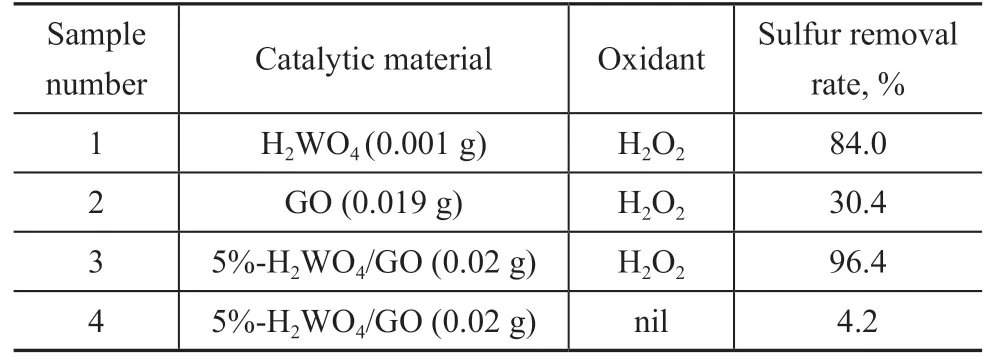
Table 2 Desulfurization rate achieved by H2WO4, GO, and 5%-H2WO4/GO
3.2 Oxidative desulfurization reaction conditions
3.2.1 Influence of loading amount of H2WO4on sulfur removal
The desulfurization properties of catalyst depend on its active sites, specific surface area, and crystallinity. As shown in Figure 6, the removal rate of DBT increases from 83% to 99.4%, when the loading amount of H2WO4increases from 3% to 5%. When the H2WO4loading increases to 7%, the sulfur removal rate decreases to 92%. This phenomenon indicates that specific surface area and the H2WO4loading together can affect the performance of catalyst in ODS reaction. The optimal loading amount of H2WO4is 5%.
3.2.2 Influence of reaction temperature on sulfur removal
The effect of reaction temperature was investigated under the same desulfurization conditions. As shown in Figure 7, the removal rate of sulfur at 50 ℃, 60 ℃, and 70 ℃ is 95.8%, 98.3% and 99.2%, respectively. When the reaction temperature is low, the active constituent could not fully take part in collision of oxidants. Thus, the removal rate of sulfur is low. Because the oxidative desulfurization is an endothermic reaction, the increase of temperature improves reaction, and the removal rate of sulfur is increased[30]. In particular, when the reaction temperature is set at 70 ℃, the sulfur removal rate is almost close to 100%. In conclusion, the optimal reaction temperature is 70 ℃.

Figure 6 Influence of loading amount of H2WO4 on sulfur removal
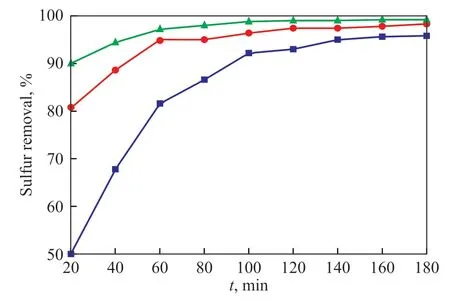
Figure 7 Influence of reaction temperature on sulfur removal
3.2.3 Influence ofn(O)/n(S) ratio on removal of sulfur
The H2O2plays the role of an oxidant in ODS reaction,and is an important factor for the removal of sulfur.Figure 8 shows that when then(O)/n(S) ratio increases from 0 to 6, the removal rate of DBT increases from 20.8% to 99.2% in 180 min, respectively. Particularly,when the O/S molar ratio is 0, the removal rate of DBT is only 18.8%, because the -OH radicals are able to oxidize the organic-sulfur compound[31]. According to the stoichiometric reaction for converting DBT to DBTO2,only 2 mol of H2O2are required for the oxidation of 1 mole of DBT[7]. However, in this system, the actual O/S molar ratio for the complete conversion of DBT needs 6 mol of H2O2. This amount is more than the theoretical stoichiometric ratio, which may be related to the selfdecomposition of H2O2during the reaction. Upon further increasing the O/S molar ratio, there is a negligible effect on the desulfurization rates. So an optimal O/S molar ratio of 6 can be recommended.
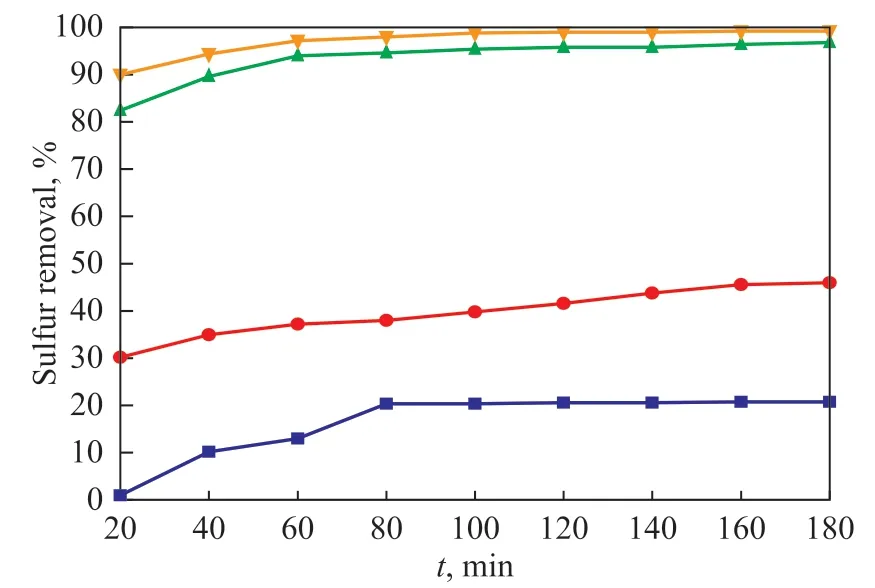
Figure 8 Influence of the n(O)/n(S) ratio on sulfur removal
3.2.4 Influence of amount of 5%-H2WO4/GO on sulfur removal rate
As shown in Figure 9, the desulfurization rate achieved by GO was only 30.4% because of the adsorption by GO[28]. When the amount of catalyst was raised from 0 g to 0.015 g, the results indicated that the sulfur removal rate increased from 6 % to 80.8%. When the amount of catalyst was 0.020 g, the sulfur removal rate was 99.2%.Above all, increasing the catalyst amount can enhance the DBT removal rate, because the catalytic active sites in the system are enriched[32]. Owing to the sulfur removal rate was almost equal to 100%, it is not needed to further add the amount of catalyst. Thus, the optimal catalyst amount is 0.020 g.
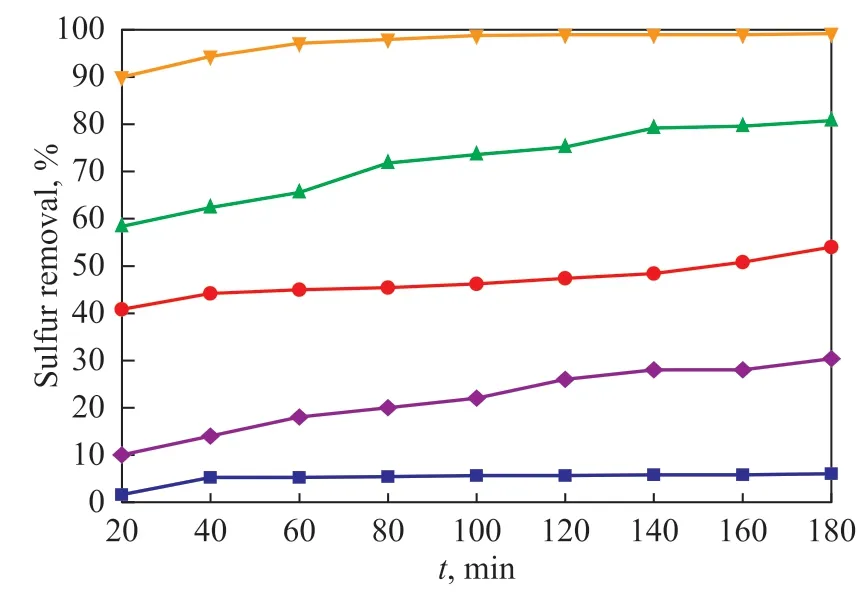
Figure 9 Influence of the catalyst amount of 5%-H2WO4/GO on sulfur removal
3.2.5 Influence of acetonitrile dose on removal of sulfur
Acetonitrile is the extraction agent in the ODS process,and the acetonitrile dose can also affect the sulfur removal rate. The experimental results are presented in Figure 10.When an acetonitrile dose of 0.5 mL, 1.0 mL, and 1.5 mL was used, the sulfur removal rate reached 67%, 99.2%,and 89.2%, respectively. It can be seen from Figure 10 that the desulfurization rate rises at first and then declines with an increase of acetonitrile dose. This reason is that the decrease of the oxygen/sulfur ratio in the system leads to more DBT being extracted into the acetonitrile phase when the amount of H2O2remains unchanged[33]. Thus,the optimal acetonitrile dose is 1.0 mL.

Figure 10 Influence of the acetonitrile dose on sulfur removal
3.2.6 Influence of different kinds of sulfur compounds on sulfur removal rate
Different kinds of sulfur compounds are found in fuel oil, for example, dibenzothiophene (DBT),4,6-dimethyldibenzothiophene (4,6-DMDBT), and benzothiophene (BT). The experimental results are shown in Figure 11. The sulfur removal rate was 99.2%, 95%,and 42.8% for DBT, 4,6-DMDBT, and BT, respectively.The oxidative desulfurization activity of the model oil depends on the electron cloud density of sulfur atoms in the organic sulfur compounds. Findings in the literature indicate that the electron cloud density of the sulfur atoms is 5.758 (DBT), 5.760 (4,6-DMDBT), and 5.739 (BT)[34].A lower electron cloud density of sulfur atoms results in a lower desulfurization rate. The electron cloud density of sulfur atoms in DBT is lower than that of 4,6-DMDBT,but the desulfurization rate of DBT is higher than that of 4,6-DMDBT. It may be ascribed to the steric hindrance of the methyl substituent for 4,6-DMDBT, which hinders the approach of sulfur atoms to catalytic active centers[35].Therefore, the removal rate of 4,6-DMDBT is a little lower than that of DBT. Therefore, the desulfurization rate still decreases in the following order: DBT > 4,6-DMDBT >BT.
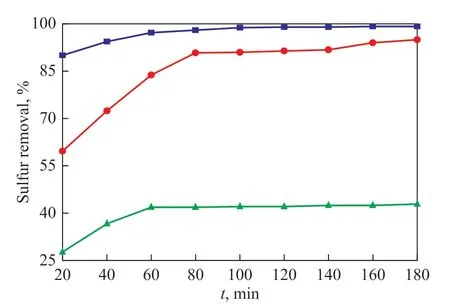
Figure 11 Influence of different sulfur compounds on sulfur removal
3.3 Kinetics analysis
In order to investigate the performance of catalyst,reaction kinetics is used to describe the reaction mechanism of oxidative desulfurization. The previous research has shown that the reaction mechanism of oxidative desulfurization of model oil accords with the first-order reaction kinetics equation[36]:

The analysis of kinetics for removal of DBT, 4,6-DMDBT,and BT using 5%-H2WO4/GO as catalyst is shown in Figure 12(a), whereC0is the initial sulfur concentration,Ctis the residual sulfur concentration at a timet(min),kis the kinetics constant for the first order reaction andR2is the correlation coefficient. Thekvalue for DBT,4,6-DMDBT, and BT is 0.02635 min-1, 0.02519 min-1,and 0.00016 min-1, respectively. In addition, theR2value of DBT, 4,6-DMDBT, and BT is 0.99916, 0.98693,and 0.91904, respectively. So the sulfur removal rate of samples decreases in the following order: DBT >4,6-DMDBT > BT. These experimental results are consistent with those reported by Lo, et al.[36]
3.4 Apparent activation energy
Kinetic experiments of the ODS reaction were performed at various temperatures. As shown in Figure 12(b), plots are observed to be straight lines in all case, and the rate constantkdecreases in compliance with the following reaction temperature: 70 ℃>60 ℃>50 ℃. Meanwhile,the ODS process also follows the pseudo-first-order kinetics. Thekvalue is 0.01595 min-1, 0.01854 min-1, and 0.02387 min-1for 70 ℃, 60 ℃ and 50 ℃, respectively.The Arrhenius equation is seen in the equation (4)[2].Upon taking 1/(RT) as the abscissa and lnkas the ordinate to make a graph, hereink0is the pre-exponential factor,Eais the apparent activation energy, andRis the thermodynamic constant. As shown in Figure 12(c), an apparent activation energyEa=18.515 kJ/mol can be obtained for DBT.
3.5 Recycling of catalyst
The regeneration of the catalyst should be environmentally friendly. First of all, the catalyst was washed with carbon tetrachloride (CCl4). The catalyst was separated from other impurities by centrifugation.The reproducibility of the catalyst activity in terms of the DBT removal rate slightly decreased under the same experimental conditions, with the experiment results presented in Figure 13. The results indicate that the DBT removal rate slightly declined due to a slight loss of the catalyst and a decrease of sulfide oxidant in catalyst during the recycled use of catalyst. But, the desulfurization rate of the DBT feed still reached 88.0%after four recycles of the catalyst.
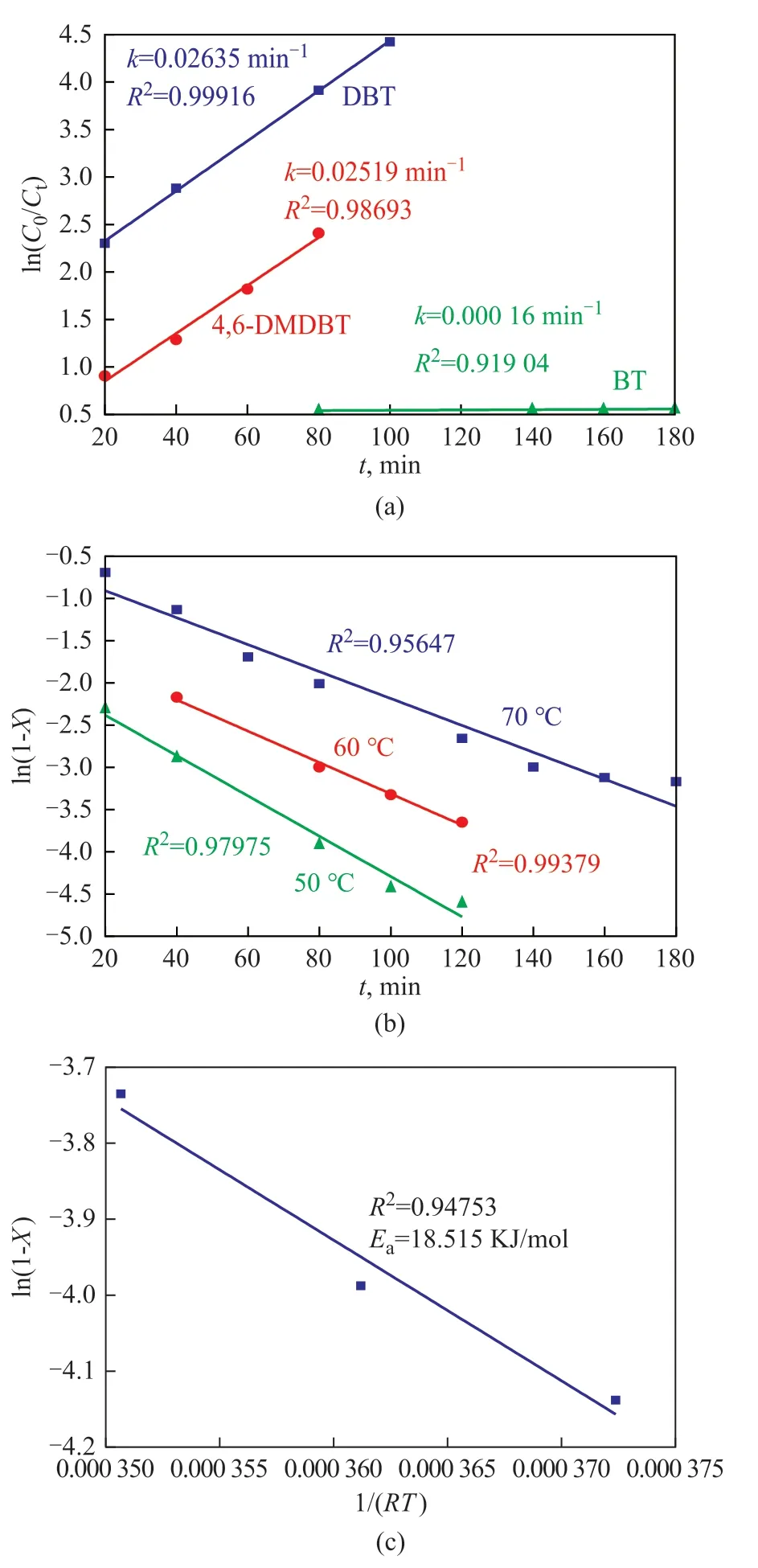
Figure 12 The kinetics analysis and activity energy in the oxidation desulfurization
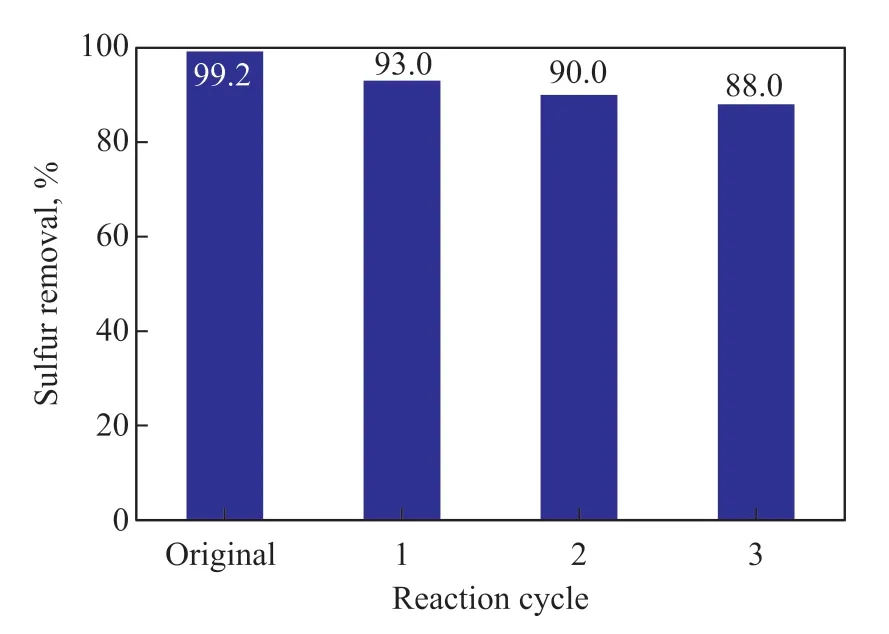
Figure 13 Recycle performance of catalyst
3.6 Mechanism of catalyzed oxidative desulfurization
In the ODS reaction, there are three processes composed of adsorption, catalytic-oxidation and extraction, which are demonstrated in Scheme 1. The DBT is completely extracted into the acetonitrile phase[37]and absorbed onto the catalyst. H2WO4is oxidized to H2[WO (O2)2(OH)2]under the action of H2O2. The catalyst H2[WO(O2)2(OH)2]can oxidize the sulfur compounds, such as DBT,4,6-DMDBT, and BT. Some sulfur compounds are oxidized in acetonitrile, the oxidation products of sulfur compounds in model oil are further extracted into acetonitrile to keep an extraction equilibrium process.
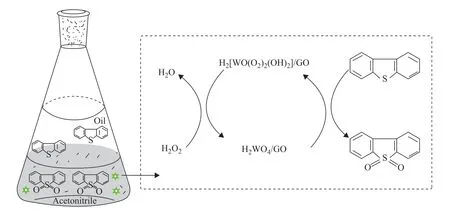
Scheme 1 the mechanism of oxidative desulfurization
4 Conclusions
The H2WO4/GO catalyst is prepared by a simple method.H2WO4/GO acting as catalyst, H2O2acting as oxidant and acetonitrile acting as extraction agent are used in the ODS process. The catalyst exhibits high desulfurization activity and the sulfur removal rates reaches 99.2% and 95% for DBT and 4,6-DMDBT, respectively. The optimal reaction conditions covered: a dosage of 0.02 g of 5%-H2WO4/GO catalyst, a reaction temperature of 70 ℃, an(O)/n(S) ratio of 6, and an acetonitrile dosage of 1 mL.Introduction of H2WO4into the layers of GO can ensure the stability of catalyst. The catalyst can be recycled for four times with a slight decrease of its desulfurization activity. Therefore, it is obvious that the H2WO4/GO has definitely shown its potential for application in the ODS process.
Acknowledgements:The authors also acknowledge the financial support of the Doctoral Fund of Liaoning Province(201501105).
杂志排行
中国炼油与石油化工的其它文章
- Effect of Acidity on Methylation of Benzene with Methanol Catalyzed by HZSM-5: A DFT Study
- Study on Reducing Injection Pressure of Low Permeability Reservoirs Characterized by High Temperature and High Salinity
- Heat Transfer and Kinetics Study of Moroccan Oil Shale Pyrolysis Process
- Application of a New Catalyst Deactivation Model for Residue Hydrotreating
- High-efficiency Extraction of Bitumen from Oil Sands Using Mixture of Ionic Liquid [Emim][BF4] and Dichloromethane
- Heat Exchanger Network Retrofit of Diesel Hydrotreating Unit Using Pinch Analysis
